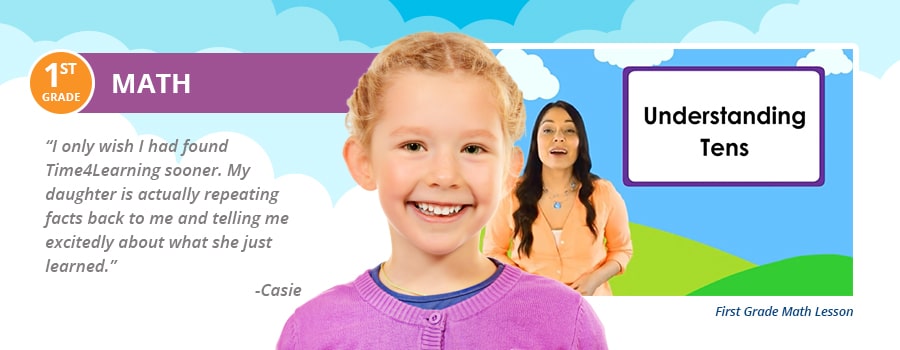First Grade Online Homeschool Math Curriculum
A first grade math curriculum should teach students the fundamentals in a way that is not just effective, but also fun. In addition to giving students a solid foundation, first grade math fluency also arms students with the tools and confidence they need to learn more advanced concepts down the road.
If a child can’t keep up with a first grade math curriculum, not only will they fall behind and, in turn, lose confidence, but they’ll also lose interest in the subject. Additionally, the skills and concepts that students learn in first grade math aren’t just limited to use in their academic studies. First grade math fluency also helps students become better problem solvers and logical thinkers.
What Math Should a 1st Grader Know
Students will acquire tons of new math skills in first grade. This knowledge will serve as a foundation for what they will learn in second grade math and also expand on what they learned in kindergarten. As they go into first grade, students should be familiar with a number of concepts in order for them to be successful and learn more advanced topics and math strategies. These include, but are not limited to:
- Be able to count, identify and write numbers
- Perform one-digit addition and subtraction
- Have an understanding of quantity (more and less)
- Familiarity with patterns and shapes
- Knowledge of place value (ones, tens, etc.)
The ideal math curriculum for first grade should not only build on these skills and ensure mastery of new concepts, but also make learning fun by engaging and motivating students.
Math Objectives for 1st Grade
Once you’ve selected the ideal math curriculum, it is important to set some attainable goals. Below is a sample of what some of these math goals should be:
- Count to 100; county by 5s and 10s to 100; count by 2s to 40
- Represent numbers on a number line
- Add and subtract 2-digit numbers
- Write the date; tell time; read a calendar
- Count and create coin combinations; add and subtract money
- Identify, sort and classify 2-dimensional shapes
- Understanding the value of money
Towards the end of the year, if your child has already achieved most of their first grade math goals you can give them a head start for the next year by having them practice math facts. This will solidify what they learned in first grade and prepare them for their second grade math learning targets.
1st Grade Math Scope & Sequence
Read whole numbers up to 100. Use one-to-one correspondence to count objects up to 100.
Compare and order whole numbers up to 100 by understanding the concepts of greater than, less than, and equality.
Match ordinal numbers with an ordered set of up to ten items. Identify first, second, and third by name.
Count forward and backward by ones and count forward by tens from any number less than 100.
Identify the place value of a digit in whole numbers to 100. Identify the value of digits up to the hundreds place.
Group objects by tens and ones. Compare and order whole numbers up to 100 using place value.
Count forward by twos and fives up to 50.
Model and identify even and odd numbers.
Chapter Test: Number Sense
Identify equal and unequal parts of wholes.
Identify and demonstrate fractions (1/2, 1/4) as parts of whole and parts of a set using concrete materials and drawings.
Identify and demonstrate thirds and 1/3 of wholes using concrete materials and objects.
Identify equivalent fractional parts as a whole.
Demonstrate understanding of the meaning of addition and subtraction by using language such as put together, take away, increase, decrease, compare, and find the difference. Relate informal language to mathematical language and symbols.
When given any number up to 100, identify one more than, one less than, 10 more than, and 10 less than.
Using diagrams and/or numerical expressions, represent equivalent forms of the same number up to 12.
Solve one-digit addition problems.
Solve one-digit subtraction problems.
Find the sum of three one-digit numbers.
Solve two-digit addition problems.
Explain the meaning of zero and its function as a placeholder. Explore adding and subtracting zero.
Solve for basic addition and subtraction facts by using strategies such as counting on, counting back, doubling, doubling plus one, and making ten.
Solve addition and subtraction one-digit word problems by selecting the proper operation.
Choose an appropriate method, such as using concrete materials, mental math, or paper and pencil to solve real-world addition and subtraction problems.
Use the appropriate language of estimation such as about, near, closer to, and between to identify and describe numbers in real-world situations.
Estimate reasonable answers to compare amounts, count objects, and solve basic facts.
Identify and name the values of coins (penny, nickel, dime) and show different combinations of coins that equal the same value, up to 75¢. Recognize and use the cents sign.
Identify and count money to equal an amount using the fewest coins.
Identify and count money to equal an amount using the fewest coins.
Solve simple addition and subtraction problems involving the use of pennies, nickels, and dimes up to 50¢.
Sort and classify objects by one attribute.
Sort and classify objects by two or more attributes.
Justify rules for sorting and classifying.
Use one attribute to create a pattern. Identify errors in repeating patterns.
Classify, describe, and extend patterns of objects using a wide variety of attributes (i.e., size, shape, color).
Predict and extend pictorial patterns. Identify and generate patterns in number pairs by adding to a T-chart.
Explore and create repeating patterns and growing patterns and generate rule for such patterns.
Explore patterns of numbers on a hundreds chart.
Use patterns to skip count by 2s, 5s, and 10s to 100. Understand and identify odd and even numbers.
Predict and extend existing numerical patterns using addition.
Use the Commutative Property of Addition in solving problems.
Using objects and pictures, model situations that involve the addition and subtraction of whole numbers.
Identify fact families by understanding the patterns in related addition and subtraction sentences.
Using objects, create models that represent a variety of number sentences including the missing addend.
Use concrete objects and pictorial representations to explore equalities and inequalities.
Use concrete objects to solve number sentences with equalities and inequalities using the symbols <, =, >.
Solve addition and subtraction problems with an unknown number represented by a geometric shape.
Compare plane figures based on their straight and curved lines.
Identify open and closed figures.
Identify circles, triangles, and rectangles (including squares), and describe the shape of balls, boxes, cans, and cones. Sort shapes by attributes (sides, curves, corners).
Recognize plane shapes such as hexagons, trapezoids, and rhombi.
Describe and compare attributes (sides, vertices, angles) of two-dimensional shapes.
Recognize solid shapes such as spheres, cylinders, cones, and cubes.
Describe and compare attributes (edges, vertices, faces) of three-dimensional shapes.
Identify congruent two- and three-dimensional shapes.
Describe relative positions of objects or shapes using words such as top, middle, on, inside, and outside.
Interpret directional words such as left, right, up, and down.
Identify, locate, and move objects according to positional words such as to the left, above, and behind.
Locate, plot, and identify known and unknown numbers on a number line from 0 to 20 by ones and from 1 to 100 by tens.
Identify slides and turns with objects.
Identify matching pairs of congruent figures that have been turned or flipped.
Identify lines of symmetry in two-dimensional shapes.
Chapter Test: Using Shapes
Create two-dimensional and three-dimensional shapes using other shapes (e.g., two squares make a rectangle).
Recognize two- and three-dimensional shapes from various perspectives.
Compare perimeter and area of two-dimensional shapes in terms of less than, equal to, or greater than.
Recognize geometric shapes in the environment.
Use pattern blocks to form shapes. Identify combined shapes in nature, art, and architecture.
Chapter Test: Spatial Sense
Identify the names of the week and months of the year using a calendar.
Identify the keywords that name the passage of time such as yesterday, afternoon, night, and day.
Identify tools for measuring time such as clocks and calendars and name parts of each tool.
Tell time on analog and digital clocks to hour and half hour, and relate time events using shorter/longer.
Tell time on analog and digital clocks to hour and half hour, and relate time events using shorter/longer.
Solve simple real-world problems involving elapsed time to the hour and half hour and minutes.
Use nonstandard units to estimate and measure lengths.
Compare the length of two or more objects by using direct comparison or by using nonstandard units.
Use customary units to measure, compare, and order objects according to lengths, in inches and feet.
Choose the appropriate unit and tool to measure length.
Use metric units to measure, compare, and order objects according to lengths.
Use nonstandard units to estimate and measure weights.
Compare the weight of two or more objects by using direct comparison or by using nonstandard units.
Compare the weight of two or more objects using customary units and identify the tools for measuring weight.
Use metric units to measure, compare, and order objects according to weights.
Use nonstandard units to estimate and measure capacity.
Compare the capacity of two or more containers using direct comparison.
Compare the capacity (in cups, pints, and quarts) of two or more containers. Identify the tools for measuring capacity.
Use metric units to measure, compare, and order objects according to capacity.
Using a Fahrenheit thermometer, tell temperature to the nearest 10 degrees. Match temperature in degrees Fahrenheit to the feeling outside of a warm or cold day.
Compare temperatures in degrees Fahrenheit of two or more objects. Identify tools for measuring temperature.
Chapter Test: Temperature
Sort objects into categories and create a tally table.
Organize and record data in pictographs.
Organize and record data in bar graphs.
Interpret data and explore range and mode in simple graphs.
Use data to make predictions about events or situations.
Identify whether an event is certain, possible, or impossible.
Identify the likelihood of a given event.
Chapter Test: Probability
Why Choose Time4Learning First Grade Math Homeschool Curriculum
Without a thorough understanding of foundational math skills, students will find it difficult to keep up with a first grade math curriculum. As we all know, in order to keep a young child engaged and to instill a lifelong love of learning they need to enjoy the lessons.
Time4Learning makes learning fun for first graders through interactive, multimedia-based lessons that feature colorful animations, funny characters, and catchy songs — all of which help children learn, retain information, and have fun. With a simple-to-follow format that builds on previous material, students are able to expand their knowledge and build their first grade math fluency in order to master concepts in number sense, addition, subtraction, estimation, money, patterns, and more.
In addition to providing an award-winning curriculum for students, Time4Learning can help your student achieve all their first grade math goals and objectives with our flexible, student-paced curriculum. It also offers convenient tools for parents that help you save time and homeschool with confidence. Learn more about our online first grade homeschool curriculum, designed to help your child learn and master their fundamental concepts.






